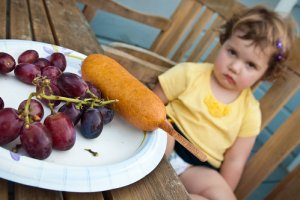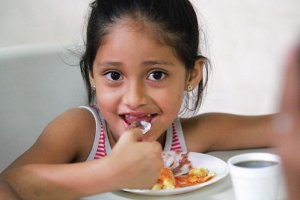 There is no limit to the number of myths and bad information surrounding the topic of picky eating. Bad advice usually comes from well-intentioned family and friends, and sometimes from the medical community itself. But when bad advice doesn’t work, or worse, when it backfires, it can lead to a cycle of stress in that turns mealtime into a negative experience.
There is no limit to the number of myths and bad information surrounding the topic of picky eating. Bad advice usually comes from well-intentioned family and friends, and sometimes from the medical community itself. But when bad advice doesn’t work, or worse, when it backfires, it can lead to a cycle of stress in that turns mealtime into a negative experience.
There are many reasons children become picky eaters. These reasons include:
- Underlying developmental or medical issues
- Sensory processing difficulties
- Anxiety
- Stress in the home
- Trauma
- Swallowing issues
- Early, negative experiences with food such as episodes of choking, gagging, or reflux
Unfortunately, picky eating is often seen as a behavioral problem.
Some children simply need time to learn and explore a variety of food while others require intervention. In this blog we’ll explore some common misconceptions about picky eating and separate myth from fact.
https://www.youtube.com/watch?v=rYwz8svzVUA
Myth: Picky eating is a behavioral problem.
Fact: Picky eaters are in a state of “fight” or “flight”, an unconscious response of the nervous system when faced with “danger”.
In this first video, Super Nanny attempts to help two families dealing with feeding challenges. In the first clip we meet a little boy who gags when attempting to eat a cheese sandwich. Super Nanny tells his mom that she must set stronger boundaries around mealtime including not allowing him to leave the table without eating his food and ignoring his “behavior”.
For some children, the cause of picky eating is complicated, but it’s rarely, if ever, behavioral. Gagging is an instinctual reaction to certain foods and textures. Gagging with food is a cause for concern, not a sign of defiance. It signals that a child is in a state of “fight” or “flight”, an involuntary and evolutionary reaction to protect our bodies when we perceive danger (Harris et al, 2019). Forcing a child to eat something that causes such an intense reaction can lead to distrust between parent and child and will likely make the problem worse (Walton et al, 2017).
Myth: Let them go to bed hungry and they’ll learn to eat what they’re served.
Fact: Many picky eaters would rather go hungry than be forced to eat something that disgusts them. Some children will go hungry for days, leading to an increased risk in health issues.
The second clip features a young girl who is literally force-fed by her desperate mother while the child is crying and screaming. The little girl has been hospitalized for malnourishment and mom feels like she is out of options. To her credit, Super Nanny explains that force-feeding is causing a great amount of anxiety for the child. She then suggests a tactic that many parents have tried: let the girl go to bed hungry. We then watch as this child cries and screams in distress when she’s taken to bed on an empty stomach.
Once again, we see a behavioral approach used on a young child, but this time the child has a serious problem with malnutrition. Instead of addressing what is happening inside of this child’s body to cause her such distress at mealtime, we assume that she is making a conscious decision to starve herself. These types of behavioral approaches, in this case punishment for not eating, lacks credibility and shows no long-term improvement in children. Any success is often short lived (Reisoso et al, 2018). In quantitative studies, the reward/punishment approach to picky eating often leads to increased stress to an already stressful situation (Wolstenholme et al, 2020).
What Works
With both children, we see small yet important progress throughout the video. However, the progress we see is likely due to non-behavioral interventions:
- Food exploration

- Reduced stress at mealtime
- Making mealtime fun
- Allowing the children to feel some control by giving then guided choices
When picky eating stems from sensory issues, difficulties eating certain textures, tastes, etc., allowing the child to explore and describe how food looks, tastes, and feels can decrease their fear and they’ll be more likely to try new things (Harris et al, 2019). Eliminating stress at mealtime and allowing children to explore various foods without the expectation of eating will increase trust in the parent-child relationship and children will feel safe to explore new things.
https://www.youtube.com/watch?v=1SVEDZltzUc&t=12s
Myth: Snacks make kids picky eaters.
Fact: Snacks make kids full, not picky.
In this video, we see an example of how medical professionals sometimes provide wrong information. While discussing the natural progression of eating habits in toddlers, this doctor recommends to parents that if a child does not eat what the adults are eating, they should let their child go hungry until they eat what is served. She also says that snacking is the cause of picky eating.
This doctor is correct when she says the appetite slows as children enter their toddler years. When we’re babies, eating is a reflex. We feel hungry, we eat. But as we grow, that reflex disappears. This is also a time of increased independence and autonomy, and children naturally begin to assert control over their environment (Walton et al, 2017).
If a child has too many snacks, they won’t be hungry. This makes perfect sense. However, not feeling hungry and being severely selective are two separate issues. When a picky eater is given the option to either eat or don’t eat, they will almost always choose to not eat. This is because the fear and disgust they feel is real. Their brain and body experience a strong reaction to specific foods. Denying a child food will not make picky eating better, but it will set up a pattern of distrust and likely make the problem worse (Harris et al, 2019).
What works
Time. Patience. Exploration.
Allow children to participate in food preparation. Allow them to touch, feel, smell, and play with food. As children learn that food is safe, they will be more likely to taste it and may find that they enjoy trying new things.
By: Nenad Stojkovic
https://www.youtube.com/watch?v=qixyAuIJmxo
Fact: Picky eating happens on a vast spectrum and no two children are the same.
In this last video, we’re introduced to Erin, a 7-year-old diagnosed with Food Neophobia, or a fear of food. ABC News follows Erin for one year on her journey to accept a broader, more nutritious diet. Erin participates in a 5-day, intense feeding program designed for individuals with eating disorders. When we revisit with Erin one year later, she is eating a much more diverse diet.
This video illustrates the difference between picky eaters and what experts refer to as problem feeders. Problem feeders eat an extremely limited diet, generally 10 foods or less, and tend to experience significant anxiety when introduced to new or non-preferred foods (Harris et al, 2019). In Erin’s case, she experiences anxiety just looking at certain foods or textures and eats only foods that are familiar and “safe”.
Harris et al, 2019, describes how early negative experiences with food can lead to severe anxiety later in childhood, leaving an imprint on the brain, and leading to unconscious fear and selective eating. In Erin’s case, she had terrible reflux as a baby, likely leading to her neophobia. Erin’s mom admits that following advice such as “she’ll eat when she’s hungry” and “she’ll grow out of it” has not worked.
What works
Although Erin’s story is an example of a more serious picky eater, we see how intervention helped her move past her fears. When her sensory and anxiety issues are finally addressed, she begins to explore and enjoy a variety of food.
What the research says
Make mealtime fun! Children who participated in early sensory play were more likely to taste fruits and vegetables, while simply touching different foods decreased neophobia in preschool children (Coulthard & Sealy, 2017) (Coulthard and Thakker, 2015).
Kids are more likely to explore and try new things when the pressure to eat is eliminated. Conversely, research shows that when parents pressure kids to eat, it is likely to backfire. The child becomes more defensive, and the family experiences heightened stress (Walton et al, 2017).
- Lose the rewards and punishments
There is simply no research that shows either punishment or rewards work for picky eating. In fact, studies show that behavioral approaches almost always make the problem worse (Wolstenholme et al, 2020).
- Know when to ask for help
If a child has difficulty gaining weight or experiences gagging, vomiting, or choking when eating, it may be a sign of a more serious problem. Reach out to the child’s pediatrician and request feeding therapy with a qualified speech or occupational therapist.
Children are naturally curious and playful. Play is how we learn about our bodies and our environment. Introducing play into the world of food will help decrease negative reactions and increase enjoyment and participation with mealtime!
References
Coulthard, H., & Sealy, A. (2017). Play with your food! sensory play is associated with tasting of fruits and vegetables in preschool children. Appetite, 113, 84–90. https://doi.org/10.1016/j.appet.2017.02.003
Coulthard, H., & Thakker, D. (2015). Enjoyment of tactile play is associated with lower food Neophobia in preschool children. Journal of the Academy of Nutrition and Dietetics, 115(7), 1134–1140. https://doi.org/10.1016/j.jand.2015.02.020
Harris, A. A., Romer, A. L., Hanna, E. K., Keeling, L. A., LaBar, K. S., Sinnott-Armstrong, W., Strauman, T. J., Wagner, H. R., Marcus, M. D., & Zucker, N. L. (2019). The central role of disgust in disorders of food avoidance. International Journal of Eating Disorders, 52(5), 543–553. https://doi.org/10.1002/eat.23047
Reinoso, G., Carsone, B., Welden, S., Powers, J., & Bellare, N. (2018). Food Selectivity and Sensitivity in Children with Autism Spectrum Disorder: A Systematic Review Defining the Issue and Evaluating Interventions. New Zealand Journal of Occupational Therapy, 65, 36–42.
Walton, K., Kuczynski, L., Haycraft, E., Breen, A., & Haines, J. (2017). Time to re-think picky eating?: A relational approach to understanding picky eating. International Journal of Behavioral Nutrition and Physical Activity, 14(1). https://doi.org/10.1186/s12966-017-0520-0
Wolstenholme, H., Kelly, C., Hennessy, M., & Heary, C. (2020). Childhood fussy/picky eating behaviours: A systematic review and synthesis of qualitative studies. International Journal of Behavioral Nutrition and Physical Activity, 17(1). https://doi.org/10.1186/s12966-019-0899-x





I love that you chose this topic! As someone that has worked on feeding therapy with kids for a while, I think it is a topic that is greatly misunderstood and under acknowledged. So many kids struggle with foods, and need that extra help to get them to where they need to be! Picky eating is a thing, but can become such a bigger problem if it is not addressed. The myths/facts you chose were awesome, and the post was written so clearly making it easy to read. Nice job!